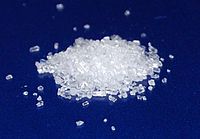- Zinc sulfate
-
Zinc sulfate 
 Zinc sulfateOther names
Zinc sulfateOther namesIdentifiers CAS number 7733-02-0  ,
,
7446-19-7 (monohydrate)
13986-24-8 (hexahydrate)
7446-20-0 (heptahydrate)PubChem 24424 ChemSpider 22833 
UNII 0J6Z13X3WO 
EC number 231-793-3 UN number 3077 ChEBI CHEBI:35176 ChEMBL CHEMBL1200929 RTECS number ZH5260000 Jmol-3D images Image 1 - [Zn+2].[O-]S([O-])(=O)=O
Properties Molecular formula ZnSO4 Molar mass 161.47 g/mol (anhydrous)
179.47 g/mol (monohydrate)
287.53 g/mol (heptahydrate)Appearance white powder Odor odorless Density 3.54 g/cm3 (anhydrous)
2.072 g/cm3 (hexahydrate)Melting point 680 ºC decomp. (anhydrous)
100 °C (heptahydrate)
70 °C, decomp (hexahydrate)Boiling point 740 °C (anhydrous)
280 °C, decomp (heptahydrate)Solubility in water 57.7 g/100 mL, anhydrous (20 °C)[1] Solubility alcohols Refractive index (nD) 1.658 (anhydrous), 1.4357 (heptahydrate) Hazards MSDS ICSC 1698 EU Index 030-006-00-9 EU classification Harmful (Xn)
Dangerous for the environment (N)R-phrases R22, R41, R50/53 S-phrases (S2), S22, S26, S39, S46, S60, S61 Flash point Non-flammable Related compounds Other cations Cadmium sulfate Related compounds Copper(II) sulfate  (verify) (what is:
(verify) (what is:  /
/ ?)
?)
Except where noted otherwise, data are given for materials in their standard state (at 25 °C, 100 kPa)Infobox references Zinc sulfate is the inorganic compound with the formula ZnSO4 as well as any of three hydrates. It was historically known as "white vitriol". It is a colorless solid that is a common source of soluble zinc ions.[2]
Contents
Production and reactivity
Zinc sulfate is produced by treating zinc with aqueous sulfuric acid:
- Zn + H2SO4 + 7 H2O → ZnSO4(H2O)7 + H2
Pharmaceutical grade zinc sulfate is produced from high purity zinc oxide:
- ZnO + H2SO4 + 6 H2O → ZnSO4(H2O)7
In the laboratory, it can also be prepared by adding solid zinc to a copper(II) sulfate solution:
- Zn + CuSO4 → ZnSO4 + Cu
In aqueous solution, all forms of zinc sulfate behave identically. These aqueous solutions consist of the metal aquo complex [Zn(H2O)6]2+ and SO42- ions. Barium sulfate forms when these solutions are treated with solutions of barium ions:
- ZnSO4 + BaCl2 → BaSO4 + ZnCl2
With a reduction potential of -0.76, zinc(II) reduces only with difficulty.
Applications
The hydrates, especially the heptahydrate, are the primary forms used commercially. The main application is as a coagulant in the production of rayon. It is also a precursor to the pigment lithopone. Zinc sulfate is used to supply zinc in animal feeds, fertilizers, and agricultural sprays. It is used as in electrolytes for zinc plating, as a mordant in dyeing, as a preservative for skins and leather and in medicine as an astringent and emetic.[2]
Minerals
As a mineral ZnSO4·7H2O is known as goslarite. Zinc sulfate occurs as several other minor minerals Zinc-melanterite (Zn,Cu,Fe)SO4·7H2O (structurally different from goslarite). Lower hydrates of zinc sulfate are rarely found in nature: (Zn,Fe)SO4·6H2O (bianchite ), (Zn,Mg)SO4·4H2O (boyleite), and (Zn,Mn)SO4·H2O (gunningite).
References
- ^ Lide, David R., ed (2006). CRC Handbook of Chemistry and Physics (87th ed.). Boca Raton, FL: CRC Press. ISBN 0-8493-0487-3.
- ^ a b Dieter M. M. Rohe, Hans Uwe Wolf "Zinc Compounds" in Ullmann's Encyclopedia of Industrial Chemistry 2005, Wiley-VCH, Weinheim. doi:10.1002/14356007.a28 537
Zinc compounds Categories:- Sulfates
- Zinc compounds
- Inorganic compound stubs
Wikimedia Foundation. 2010.
